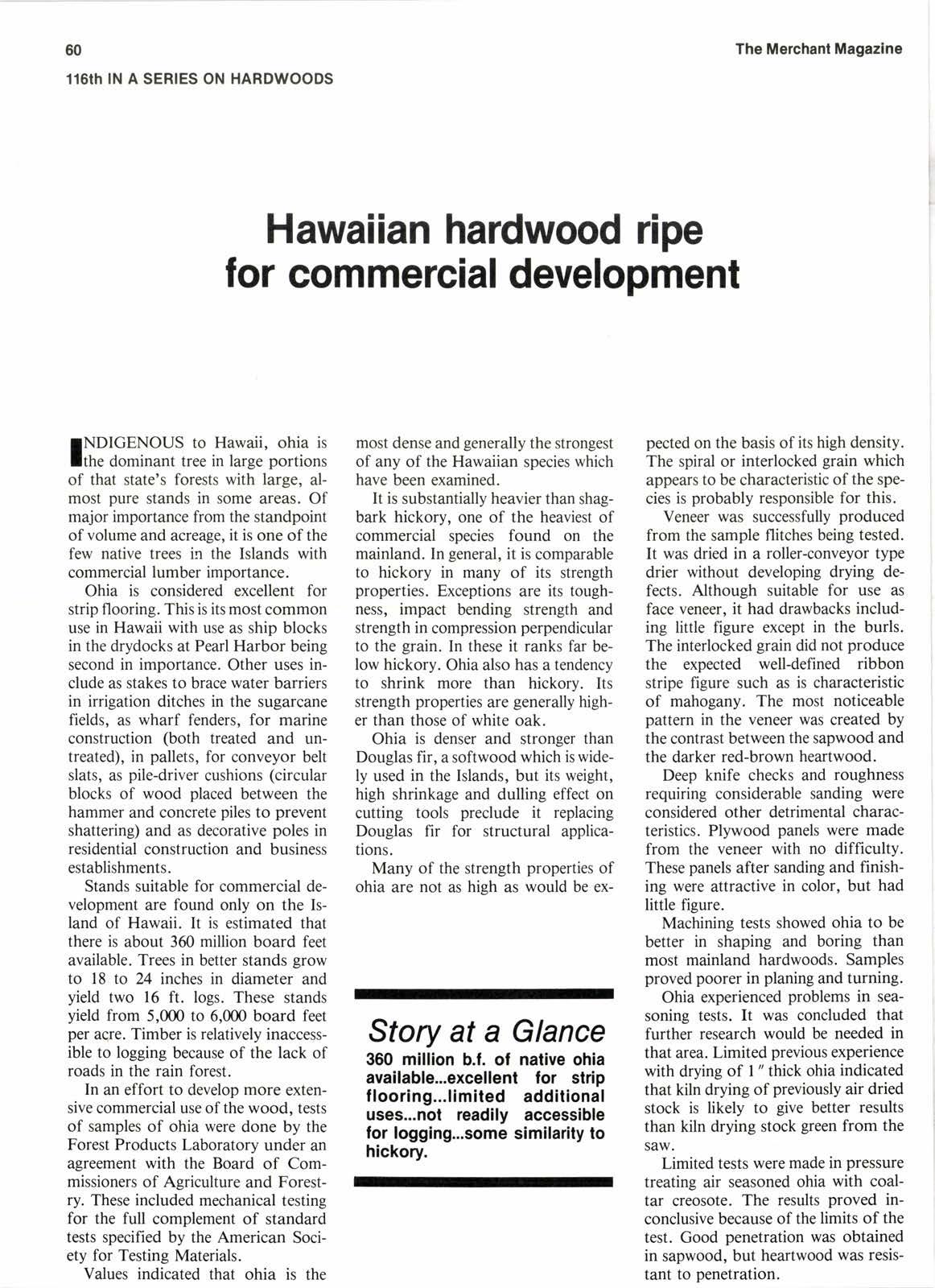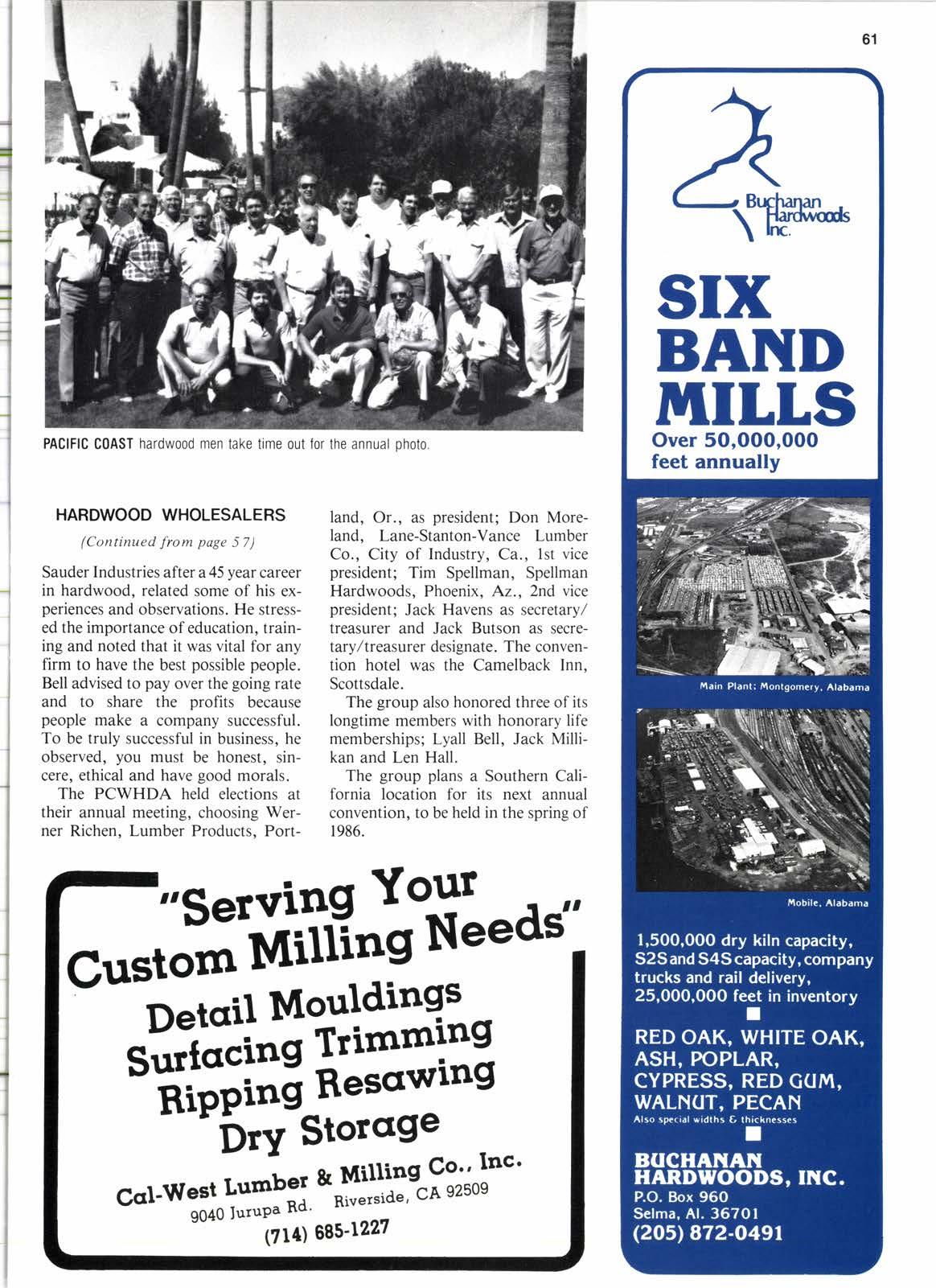
3 minute read
Hawaiian hardwood ripe for commercial development
INDIGENOUS to Hawaii, ohia is Ithe dominant tree in large portions of that state's forests with large, almost pure stands in some areas. Of major importance from the standpoint of volume and acreage, it is one of the few native trees in the Islands with commercial lumber importance.
Ohia is considered excellent for strip flooring. This is its most common use in Hawaii with use as ship blocks in the drydocks at Pearl Harbor being second in importance. Other uses include as stakes to brace water barriers in irrigation ditches in the sugarcane fields, as wharf fenders, for marine construction (both treated and untreated), in pallets, for conveyor belt slats, as pile-driver cushions (circular blocks of wood placed between the hammer and concrete piles to prevent shattering) and as decorative poles in residential construction and business establishments.
Stands suitable for commercial development are found only on the Island of Hawaii. It is estimated that there is about 360 million board feet available. Trees in better stands grow to 18 to Z inches in diameter and yield two 16 ft. logs. These stands yield from 5,000 to 6,000 board feet per aqre. Timber is relatively inaccessible to logging because of the lack of roads in the rain forest.
In an effort to develop more extensive commercial use of the wood, tests of samples of ohia were done by the Forest Products Laboratory under an agreement with the Board of Commissioners of Agriculture and Forestry. These included mechanical testing for the full complement of standard tests specified by the American Society for Testing Materials.
Values indicated that ohia is the most dense and generally the strongest of any of the Hawaiian species which have been examined.
It is substantially heavier than shagbark hickory, one of the heaviest of commercial species found on the mainland. In general, it is comparable to hickory in many of its strength properties. Exceptions are its toughness, impact bending strength and strength in compression perpendicular to the grain. In these it ranks far below hickory. Ohia also has a tendency to shrink more than hickory. Its strength properties are generally higher than those of white oak.
Ohia is denser and stronger than Douglas fir, a softwood which is widely used in the Islands, but its weight, high shrinkage and dulling effect on cutting tools preclude it replacing Douglas fir for structural applications.
Many of the strength properties of ohia are not as high as would be ex- pected on the basis of its high density. The spiral or interlocked grain which appears to be characteristic of the species is probably responsible for this.
Veneer was successfully produced from the sample flitches being tested. It was dried in a roller-conveyor type drier without developing drying defects. Although suitable for use as face veneer, it had drawbacks including little figure except in the burls. The interlocked grain did not produce the expected well-defined ribbon stripe figure such as is characteristic of mahogany. The most noticeable pattern in the veneer was created by the contrast between the sapwood and the darker red-brown heartwood.
Deep knife checks and roughness requiring considerable sanding were considered other detrimental characteristics. Plywood panels were made from the veneer with no difficulty. These panels after sanding and finishing were attractive in color, but had little figure.
Machining tests showed ohia to be better in shaping and boring than most mainland hardwoods. Samples proved poorer in planing and turning.
Ohia experienced problems in seasoning tests. It was concluded that further research would be needed in that area. Limited previous experience with drying of I'thick ohia indicated that kiln drying of previously air dried stock is likely to give better results than kiln drying stock green from the saw.
Limited tests were made in pressure treating air seasoned ohia with coaltar creosote. The results proved inconclusive because of the limits of the test. Good penetration was obtained in sapwood, but heartwood was resistant to penetration.
Hardwood Wholesalers
(Continued from page 57)
Sauder Industries after a 45 year career in hardwood, related some of his experiences and observations. He stressed the importance of education, training and noted that it was vital for any firm to have the best possible people. Bell advised to pay over the going rate and to share the profits because people make a company successful. To be truly successful in business, he observed, you must be honest, sincere, ethical and have good morals.
The PCWHDA held elections at their annual meeting, choosing Werner Richen. Lumber Products. Port- land, Or., as president; Don Moreland, Lane-Stanton-Vance Lumber Co., City of Industry, Ca., lst vice president; Tim Spellman, Spellman Hardwoods, Phoenix, Az., 2nd vice president; Jack Havens as secretary,/ treasurer and Jack Butson as secretary,/treasurer designate. The convention hotel was the Camelback Inn. Scottsdale.
The group also honored three of its longtime members with honorary life memberships; Lyall Bell, Jack Millikan and Len Hall.
The group plans a Southern California location for its next annual convention, to be held in the spring of 1986.
Over 50,000,000 feet annually


![[r [/^\/7 fl i] :-r E tR m:fl il-R tE Llut! \tu tlll Li LEUtffilt_l r,_utiut_r](https://assets.isu.pub/document-structure/230723115012-3447d49588801d2b767b1e50b42e9400/v1/d453a7018af4d3b541c1682d0084490c.jpeg)








